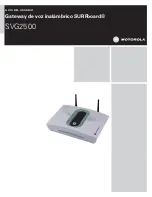
34-15
Cisco Catalyst Blade Switch 3120 for HP Software Configuration Guide
OL-12247-01
Chapter 34 Configuring Network Security with ACLs
Configuring IPv4 ACLs
After creating a numbered extended ACL, you can apply it to terminal lines (see the
“Applying an IPv4
ACL to a Terminal Line” section on page 34-19
), to interfaces (see the
“Applying an IPv4 ACL to an
Interface” section on page 34-20
), or to VLANs (see the
“Configuring VLAN Maps” section on
page 34-29
).
Resequencing ACEs in an ACL
Sequence numbers for the entries in an access list are automatically generated when you create a new
ACL. You can use the ip access-list resequence global configuration command to edit the sequence
numbers in an ACL and change the order in which ACEs are applied. For example, if you add a new ACE
to an ACL, it is placed at the bottom of the list. By changing the sequence number, you can move the
ACE to a different position in the ACL.
For more information about the ip access-list resequence command, see this URL:
http://www.cisco.com/en/US/products/sw/iosswrel/ps1838/products_feature_guide09186a0080134a60.
html
Creating Named Standard and Extended ACLs
You can identify IPv4 ACLs with an alphanumeric string (a name) rather than a number. You can use
named ACLs to configure more IPv4 access lists in a router than if you were to use numbered access
lists. If you identify your access list with a name rather than a number, the mode and command syntax
are slightly different. However, not all commands that use IP access lists accept a named access list.
Note
The name you give to a standard or extended ACL can also be a number in the supported range of access
list numbers. That is, the name of a standard IP ACL can be 1 to 99; the name of an extended IP ACL
can be 100 to 199. The advantage of using named ACLs instead of numbered lists is that you can delete
individual entries from a named list.
Consider these guidelines and limitations before configuring named ACLs:
•
Not all commands that accept a numbered ACL accept a named ACL. ACLs for packet filters and
route filters on interfaces can use a name. VLAN maps also accept a name.
•
A standard ACL and an extended ACL cannot have the same name.
•
Numbered ACLs are also available, as described in the
“Creating Standard and Extended IPv4
ACLs” section on page 34-8
.
•
You can use standard and extended ACLs (named or numbered) in VLAN maps.
•
With IPv4 QoS ACLs, if you enter the class-map {match-all | match-any} class-map-name global
configuration command, you can enter these match commands:
–
match access-group acl-name
Note
The ACL must be an extended named ACL.
–
match input-interface interface-id-list
–
match ip dscp dscp-list
–
match ip precedence ip-precedence-list
You cannot enter the match access-group acl-index command.



































